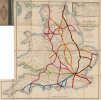A current thread on another part of the forum inspired me to speculate what the network map of the UK would look like had the system been centrally planned from the start, rather than developed piecemeal by often competing companies.
Would it be much the same as we have today, now that many ‘redundant’ lines have disappeared, but without some of the obvious anomalies and duplications?
Would it be much the same as we have today, now that many ‘redundant’ lines have disappeared, but without some of the obvious anomalies and duplications?


